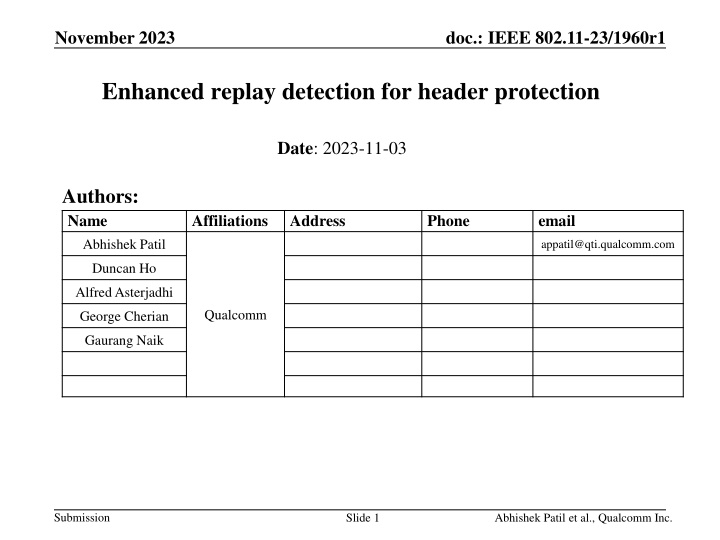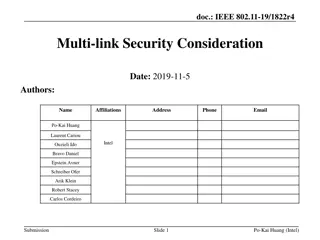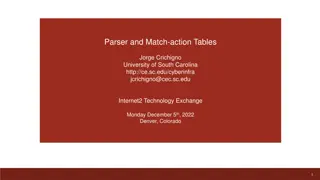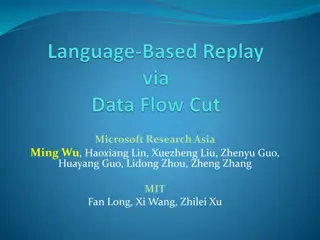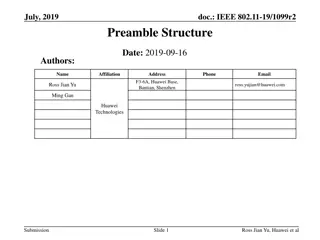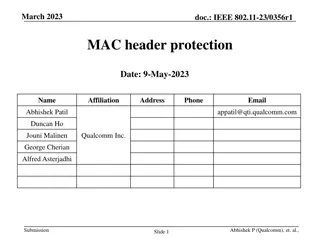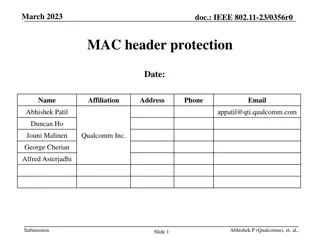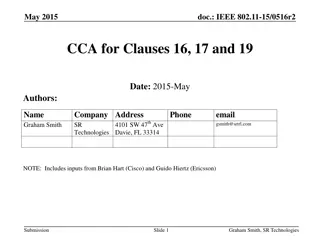Enhanced Replay Detection for Header Protection in IEEE 802.11-23/1960r1
Enhancing security in IEEE 802.11 is a key goal of UHR. This document discusses the need for improved replay detection mechanisms for header protection in the MAC layer. The proposal suggests incorporating a time component in the Packet Number (PN) to mitigate jam, record, and replay attacks. By utilizing the Time Synchronization Function (TSF) as part of the PN, receivers can discard stale frames and prevent unauthorized frame replays. However, challenges arise in synchronizing time-based PNs across devices, particularly for client devices conserving battery through periodic doze states.
Download Presentation

Please find below an Image/Link to download the presentation.
The content on the website is provided AS IS for your information and personal use only. It may not be sold, licensed, or shared on other websites without obtaining consent from the author.If you encounter any issues during the download, it is possible that the publisher has removed the file from their server.
You are allowed to download the files provided on this website for personal or commercial use, subject to the condition that they are used lawfully. All files are the property of their respective owners.
The content on the website is provided AS IS for your information and personal use only. It may not be sold, licensed, or shared on other websites without obtaining consent from the author.
E N D
Presentation Transcript
November 2023 doc.: IEEE 802.11-23/1960r1 Enhanced replay detection for header protection Date: 2023-11-03 Authors: Name Abhishek Patil Affiliations Address Phone email appatil@qti.qualcomm.com Duncan Ho Alfred Asterjadhi Qualcomm George Cherian Gaurang Naik Submission Slide 1 Abhishek Patil et al., Qualcomm Inc.
November 2023 doc.: IEEE 802.11-23/1960r1 Background Enhancing security in 802.11 is one of the goals of UHR To that effect, UHR will provide mechanisms to protect certain Control frames and fields within the MAC header. Previous proposals (see 23/1888) discuss protection the MAC header via integrity check A MIC is generated based on the fields of the MAC header. Since the contents of the header fields can change when an MPDU is retried, a fresh MIC is generated (only) for the header fields each time an MPDU is retried The payload of the MPDU is not re-encrypted Control frames are also protected via a MIC In this contribution we look at attack scenarios that warrant the need for adding a time component to the security algorithm. Specifically, we propose to have the PN be based on portion of the TSF Submission Slide 2 Abhishek Patil et al., Qualcomm Inc.
November 2023 doc.: IEEE 802.11-23/1960r1 Issue A packet number (PN) is used for replay detection A frame is considered as replayed if the received PN is <= the last received PN In other words, the PN needs to be monotonically increasing. Note The PN is included in plaintext within the frame so that the receiver knows the PN that was used for protection. There can be attack scenarios where a rogue device is able to jam the recipient from receiving the frame, while recording the frame. Later, the attacker replays the recorded frame (unmodified). This is a jam, record and replay attack Since the recipient did not receive the original frame, it does not have a record of the PN carried in that frame. As a result, the attack is successful (i.e., the attacker manages to fool the replay detection logic). The attack is especially possible when there is sparse or bursty traffic When the frame is received, the recipient can get into an undesirable state or perform unwanted actions depending on the contents of the MAC header fields For example, when the original frame indicates changes to some operational parameters, the receiver would apply them at the wrong time which would cause the transmitter and receiver to be in different states. Submission Slide 3 Abhishek Patil et al., Qualcomm Inc.
November 2023 doc.: IEEE 802.11-23/1960r1 Potential attack scenarios Submission Slide 4 Abhishek Patil et al., Qualcomm Inc.
November 2023 doc.: IEEE 802.11-23/1960r1 Solution and challenges Solution summary: The remedy for such a jam, record and replay attack is to have a time component in the PN so that the receiver can discard a stale frame. Using TSF as PN is an option Although the approach will preserve the requirement that a PN is monotonically increasing, there are challenges to this approach as described below Challenge: At the receiving device, the time based PN needs to match with the local time However, a client device is allowed to have extend periods of doze state to conserve battery. For example, a client that has indicated a listen interval (LI) of 10 is allowed to skip up to 10 beacons. TBTT occurs every 100 ms a client with LI of 10 will skip beacons for up to 1 second (10 BIs). Since the clocks run independently on each device, they will drift overtime. The standard requires an accuracy of +/-100ppm Therefore, in the worst-case drift between an AP and a client can be 200 ppm (see 11.1.3.9) As an example, a client with an LI of 10 can have its local TSF off by 200 s with respect to its AP after skipping 10 beacons (1sec). In such case, if the client has a slower clock, it will be 200 s behind the AP s TSF and a UL frame from the client will have a PN that will be 200 s in the past. This will cause the AP to discard a genuine frame since the TSF appears to be stale Submission Slide 5 Abhishek Patil et al., Qualcomm Inc.
November 2023 doc.: IEEE 802.11-23/1960r1 Addressing drift Solution: Reduce the granularity of time by ignoring lower bits of TSF to mask the clock drift The number of LSBs x to ignore is TBD. In this contribution, we provided some examples with x=8. The x value could be standardized or can be negotiated between the two devices based on their capability i.e., LI and expected drift. For example, by not including the lower 8 bits, the timing granularity reduces to 256 s which would be sufficient to address majority of the clock drift scenarios. However, the reduced time granularity means multiple packets sent within a 256 s window would be stamped with the same TSF. This will cause the receiver to drop packets To address this, append a counter to the partial TSF Counter increments each time a packet is transmitted with the same TSF value and resets to 0 when LSB of the partial TSF rolls over The overall PN is a concatenation of partial TSF + an x bit counter Assuming PN size remains unchanged (48 bits) and the lower 1 octet represent a counter: PN[0:7] = 8bit counter PN[8:47] = TSF[8:47] TSF[48:63] is not signaled Submission Slide 6 Abhishek Patil et al., Qualcomm Inc.
November 2023 doc.: IEEE 802.11-23/1960r1 Multiple tx with the same (partial) TSF At the receiving device, the replay check is performed as follows: compare the (partial) TSF with current local time and If the received value is lower than the current local (partial) TSF, drop the packet*. Else, if the received TSF is the same as the TSF received in the most recent packet, compare the received counter value: If the received counter value is equal or less than previously received counter, drop the packet Else, process the packet further Else process the packet further Record the received (partial) TSF and the counter values as the last know values (respectively) for a packet that passed replay check and subsequent checks (e.g., MIC validation) These are used for comparison with the immediately next received packet * there is a corner case when the (x+1)th bit of the TSF has recently flipped. For example (assuming x=8), receiver s 9 bits of TSFR[0:8] = 100000001; while transmitter is TSFT[0:8] = 011111101) off by 4 us In such case, since the PN value used for header protection is carried within the frame, the recipient will know that the transmitter clock is slightly behind and will still accept the frame. There can be some tolerance built into the system. Submission Slide 7 Abhishek Patil et al., Qualcomm Inc.
November 2023 doc.: IEEE 802.11-23/1960r1 PN rollover Today, when the PN wraps around (i.e., all the values are exhausted), both devices perform a rekeying operation to generate a new security key. For TSF[8:47] the wraparound would occur after 2^48 s = 3258 days Therefore, in most scenarios, TSF/PN wraparound will not be the reason for rekeying In other words, the TSF space is sufficiently long In MLO, each affiliated AP is allowed to have an independent clock As a result, TSF on each link can be a different value Consequently, a TSF based PN would be link specific This would be OK since the contents of the MAC header and Control frames are specific to a link. We could consider adding link ID as part of the PN (not strictly needed). Assuming upper byte is reserved for link ID See appendix for some calculation Submission Slide 8 Abhishek Patil et al., Qualcomm Inc.
November 2023 doc.: IEEE 802.11-23/1960r1 Summary In summary, this contribution proposes to use portion of the TSF as PN to prevent jam, record, replay attacks. The proposal accounts for clock drift and MLO considerations Proposes to add a short counter to account for loss in TSF granularity The proposal maintains the monotonically increasing properties of PN Submission Slide 9 Abhishek Patil et al., Qualcomm Inc.
November 2023 doc.: IEEE 802.11-23/1960r1 APPENDIX Submission Slide 10 Abhishek Patil et al., Qualcomm Inc.
Nov 2023 doc.: IEEE 802.11-23/1960r1 PN rollover computation If lower 8 bits of the PN is used for signaling a counter, then the PN[8:39] will carry the partial TSF: PN[0] PN[1] PN[2] PN[3] PN[4] PN[5] 2^48 sec hrs days yrs 2.81475E+14 281474976.7 78187.49353 3257.81223 8.92551296 2^40 sec hrs days yrs 1.09951E+12 1099511.628 305.4198966 12.72582903 0.034865285 Submission Slide 11 Abhishek Patil et al., Qualcomm Inc.
